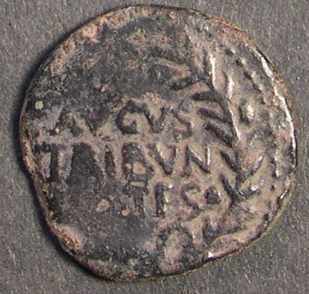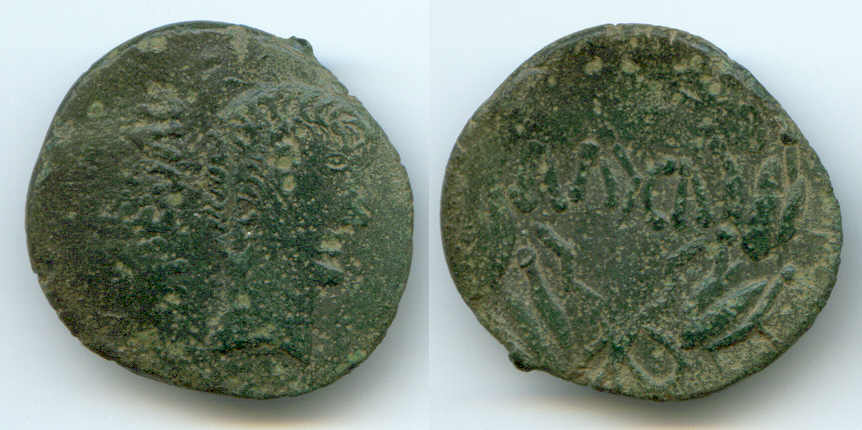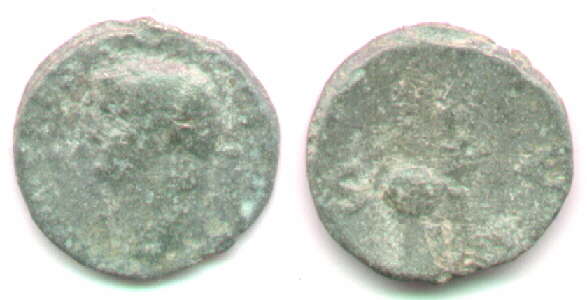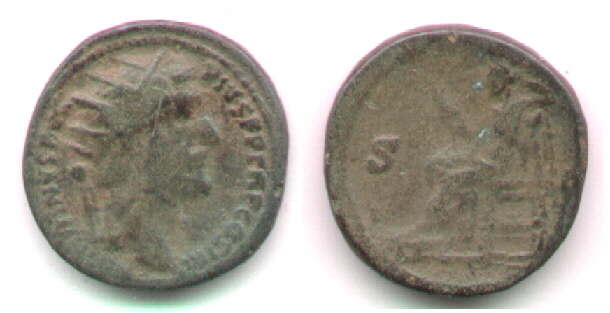DIVVS AVGVSTVS PATER (prototype struck by Tiberius c. AD 22 - 30) W
arren Esty (c) 2001
 29
mm. 6:30. 8.59 grams.
29
mm. 6:30. 8.59 grams. [Go to the page on types
of Claudius struck in Britain and other early AE imitations.]
[Go to the page on first-century silver imitations.]
Augustus (27 BC - 14 AD)
DIVVS
AVGVSTVS
PATER
(prototype struck by Tiberius c. AD 22 - 30)
W
arren Esty (c) 2001
 29
mm. 6:30. 8.59 grams.
29
mm. 6:30. 8.59 grams.
Very close to official style. Could this be official, although
light
weight?
DIVVS AVGVSTVS PATER
/PROVIDENT, altar, large
S
C
Prototype: RIC Tiberius 81, "weight
peaks
11.5 - 10.0 grams, dies mainly 12:00"
B&S VI, pp.87-100. This piece has
letters
very slightly irregular, but it is much nicer than any of the 13
imitations
pictured on pages 98-99.
BMC Tiberius 147-150.
Ex Vecchi auction 12, lot 1092.

 AE21. 10:00. 4.82 grams.
AE21. 10:00. 4.82 grams.
AVGVS / TRIBVN / POTES in wreath
SC surrounded by RVFVS IIII --- with two countermarks.
The coin appears to be an imitation of an as
struck by C. Plotius Rufus, dated 23 BC. BMC Augustus has imitations of
this obverse (which would be 150, plate 19.3). Countermarks are listed
p.xxxii-xliii and neither is listed. The CAE countermark is identifed
as of Tiberius.
 AE25-23. 7.87 grams.
AE25-23. 7.87 grams.
A crude Balkan imitation.
I don't know what this one is supposed to be.
For imitations of types of Claudius (AD 41-54), see here.
Nero (AD 54-68)


Left
facing bust/Victory left holding shield with
SPQR
and its prototype (except bust right)
Imitation: AE24. 6:00. 6.12 grams. Cast, with an edge
seam. Weak relief. Heavily patinated.
This prototype: AE26-25. 6:00. 10.17 grams.
left facing bust of Nero. Illegible legend, but prototype
NERO CAESAR AVG GERM IMP
/Victory left holding shield with SPQR
a light weight copy of a common as of Nero
Prototype: RIC 312, BMC 244. Sear 690 var.
Type of Roman
Egypt,
and its prototype
lead imitation of a tetradrachm struck at Alexandria (picture will be fixed)
bust of Nero right
/bust of Poppaea right
Imitation: lead 24. 12:00. 13.91 grams. This prototype:
Billon 27-24. 12:00. 13.00 grams.
Prototype legend in Greek: NEPO KlAVK KAIs sEB gEP AV
reverse legend: [pi]O[pi][pi]AIA sEBAsTH
Prototype year 10, AD 63/64.
Sear GI: 664.
Cast imitation in lead. Casting bubbles evident, and the arc from the side
9:00/3:00 is from the casting channel. This piece might be very worn, but,
more probably, did not have much detail to begin with.
 AE21-19. 5:30. 4.40 grams.
AE21-19. 5:30. 4.40 grams.
Semis. Garbled legends.
Laureate head right
/approximation to PONTIF MAX - TRP IMP PP usually on
a flan 2-3 mm larger.
female seated left with patera
SC below (very weak)
BMC 260, page 251, plate 45.4 or 398, plate 47.11, page 279 (with CLAVD
for CLAVDIVS)
Domitian (81-96)
 AE28. 6:00. 10.05 grams
AE28. 6:00. 10.05 grams
IMP CAES DOMIT AVG GERM COS X [some parts weak and uncertain], laureate
head of Domitian right
/SALVTI AVGVST legend retrograde, rectangular
altar
A type of AD 84.
This is a full-size imitation in yellow metal. The obverse legend is almost
complete while the reverse is retrograde.
It came with an old British ticket and may have been found in England.
References: Prototype: Sear 914. BMC 291, page 361, plate
70.7
Trajan (98-117)
 AE24. 4:30. 9.34 grams.
AE24. 4:30. 9.34 grams.
Weakly struck imitation dupondius (the crown is radiate).
Radiate head of Trajan right, with many small letters, illegible.
/awkward figure left, legend ...TRPOT - COS IIII
[COS IIII was AD 101-2.]
/in exergue, S C with "S" highly irregular.
This is not a "limes-falsa" as defined by Boon, because it is not a cast
and it is heavy weight. He suggests heavy weight casts are of the Antonine
period, but this is not a cast (in spite of the large number of tiny pits).
Clearly, it is not cast from an offical coin.
Antoninus Pius (138-161)
 AE25-24. 6:00. 11.41 grams.
AE25-24. 6:00. 11.41 grams.
Cast copy of an dupondius, AE 25-24
radiate head of Pius right, ANTONINVS AVG - PIVS PP TRP
COS IIII
/Securitas seated left, holding sceptre, left elbow on
back of chair, S C in fields left and right
11.41 grams is full weight.
Relief is low and edges are hammered (probably to hide
the casting seam)
The prototype was struck 145-161 according to BMC, and in 146 according
to Hill.
References: Boon, "Light-weights..." NC 1965, pages 167-8 says
these heavy casts are not what are known as "light weights".
Prototype: Hill 702. BMC 1742. RIC 808.
Copy of a dupondius
radiate head of Pius right, garbled legend possibly including
...HADR ANTO-N...
/Hilaritas standing left holding palm and cornucopiae.
S C on either side
Hill (p. 193) thinks the type may commemorate the adoption of Marcus. However,
he dates the prototype to 144.
Imitation of a sestertius
laureate head of Pius right, traces of a legned right
/female figure extending right arm and holding cornucopiae
in left, S in right field
References: Nothing similar in Boon.
Mabbott 4673 has one of Lucius verus "of Danubian origin."
FMRZ Lux I, plate III.316 is a crude "sestertius" of A.P.
Continue with the next page, Severan (and later) fourrés
from the Balkans.
Go to the page on types of Claudius struck in Britain and other early AE imitations.
Go to the page on first-century silver imitations.
Return to the main page on imitations.